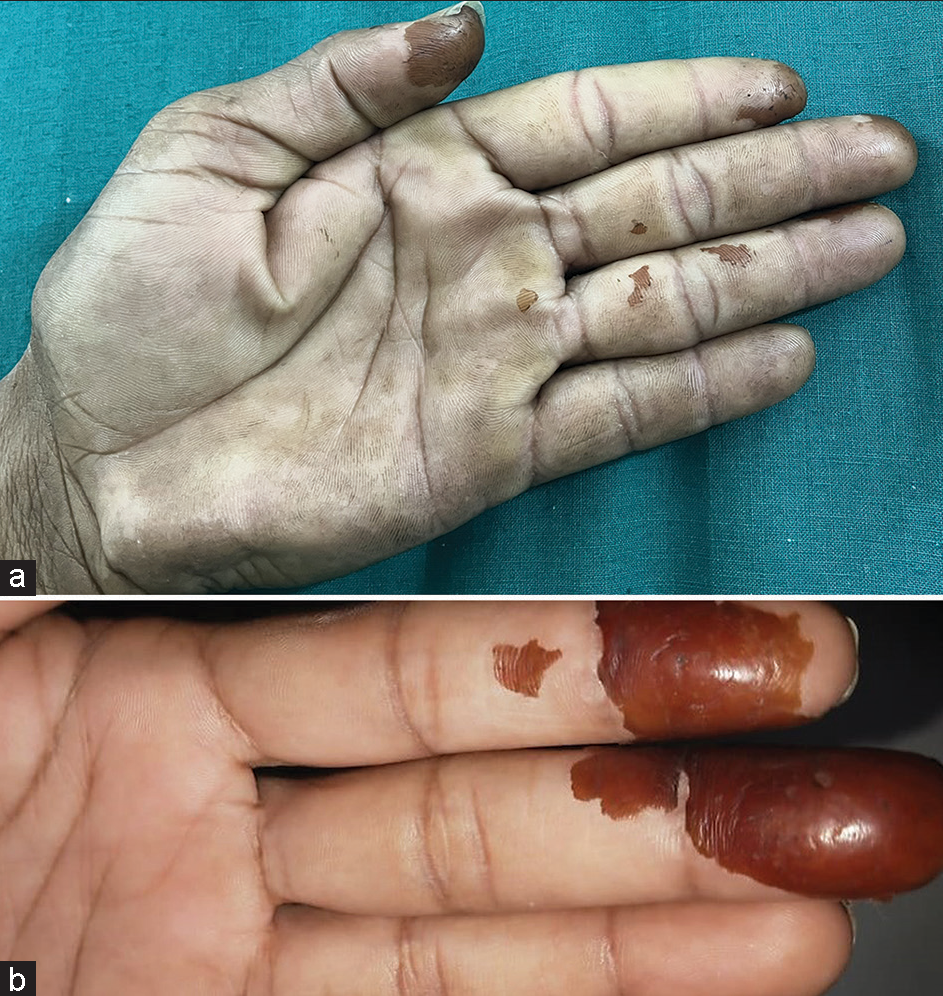Translate this page into:
Occupational dermatitis to cashew nut

*Corresponding author: Arun Somasundaram, Department of Dermatology and STD, Jawaharlal Institute of Postgraduate Medical Education and Research, Puducherry, India. arunsomasundaram25@gmail.com
-
Received: ,
Accepted: ,
How to cite this article: Ramesh N, Somasundaram A. Occupational dermatitis to cashew nut. CosmoDerma 2023;3:139.
A 45-year-old male presented with complaints of asymptomatic brownish-black discoloration over his left hand for a 4-year duration. He was a farmer by occupation and gave the history of coming into contact with raw cashew nuts and shell oil that he used to sell by hand. Cutaneous examination revealed well-demarcated brown macules over his fingers [Figure 1a]. The rest of the cutaneous examination was noncontributory. He also shared with us an image showing a similar picture in the hands of one of his coworkers [Figure 1b]. Based on the occupational history and examination, a diagnosis of cashew nut dermatitis was made, and the patient was counseled regarding the same.

- (a and b) Well-demarcated brownish macules over palms suggestive of cashew nut dermatitis.
The cashew tree, Anacardium occidentale, belongs to the Anacardiaceae family of plants. The cashew nut is composed of an inner kernel and a double-layered outer shell. Between the layers of the shell is a highly caustic brown oily liquid. This cashew nut shell liquid contains anacardic acid and cardanol, which corrode the skin, leading to irritation and chemical burns. It also contains urushiol, which can lead to allergic/irritant contact dermatitis. Urushiol is also found in mangoes, pistachios, and poison ivy and may result in cross-sensitivity.[1] The use of barrier creams and other personal protective measures will help prevent the same in cashew nut workers. It is important for dermatologists to be aware of the various occupational-related dermatoses and to manage them accordingly for the betterment of the affected individuals.
Declaration of patient consent
Patient’s consent was not required as patients identity was not disclosed or compromised.
Conflicts of interest
There are no conflicts of interest.
Use of artificial intelligence (AI)-assisted technology for manuscript preparation
The authors confirm that there was no use of artificial intelligence (AI)-assisted technology for assisting in the writing or editing of the manuscript and no images were manipulated using AI.
Financial support and sponsorship
Nil.
References
- Skin damage and aesthetic disadvantage observed in women in the hand craft shelling chain of cashew nuts in a factory to Bobo-Dioulasso, Burkina Faso. J Cosmet Dermatol Sci Appl. 2017;7:211-20.
- [CrossRef] [Google Scholar]





